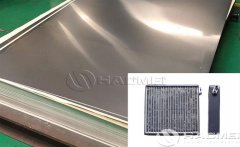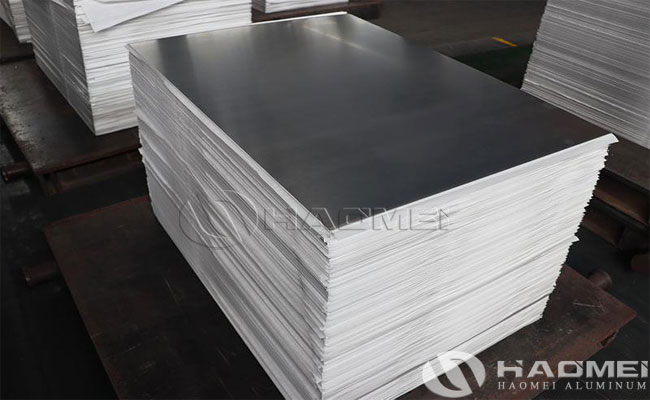-
- News Center
- Related News
-
- Aluminum Brazing Sheet For Evaporator Fin
- 2015 Haomei Annual Meeting of the New Year

- Aluminum brazing shee
-
- Home > News > Company news >
- 4045/3003/4045 Aluminum Brazing Sheet
4045/3003/4045 aluminum brazing sheet is a three-layer structure made by brazing 3003 and 4045 aluminum alloys. It combines the formability and corrosion resistance of 3003 aluminum with the excellent brazing performance of 4045 aluminum thanks to its high silicon content. Aluminum brazing sheet is widely used as heat exchange materials of intercooler, radiator fin, oil cooler, evaporator fin, condenser fin, air cooler in new energy vehicle battery thermal management systems, heat dissipation components for energy storage devices, and efficient heat dissipation for electronic devices.

Material Characteristics of 4045/3003/4045 Aluminum Brazing Sheet:
The 4045/3003/4045 composite structure consists of 4045 aluminum alloy on both sides and 3003 aluminum alloy in the middle. This design fully leverages the advantages of each alloy, making the sheet more stable during welding and providing excellent thermal conductivity.
- Surface layer 4045 aluminum alloy:
The high silicon content (approximately 9%-13%) acts as a brazing filler layer, forming a low-melting-point eutectic structure during the brazing process, ensuring metallurgical bonding between the layers. It also provides high thermal conductivity (approximately 150-180 W/(m·K)), accelerating heat transfer.
- Core Layer 3003 Aluminum Alloy:
This rust-resistant Al-Mn aluminum alloy boasts a density of 2.73 g/cm³ and offers excellent formability (elongation ≥18%), corrosion resistance (corrosion resistance in seawater and dilute acid approaches that of pure aluminum), and weldability, providing structural strength (tensile strength 120-160 MPa).
Performance Advantages of 4045/3003/4045 Aluminium Brazing Sheet:
- High Strength and Lightweight:
A hot-rolled composite process achieves metallurgical bonding between layers, resulting in higher strength than single 3003 aluminum sheet while maintaining a low density (approximately 2.75 g/cm³), contributing to weight reduction in new energy vehicles.
- Corrosion Resistance:
A dense oxide film forms on the surface of the 3003 core layer, while the 4045 surface layer forms a stable interface after brazing. The overall corrosion resistance surpasses that of ordinary aluminum sheet and is adaptable to complex environments.
- Efficient Heat Dissipation:
The high thermal conductivity of the 4045 layer combined with the low thermal resistance of the 3003 layer ensures rapid heat transfer, meeting the heat dissipation requirements of high-heat components such as battery packs and motors.
Production Process of Aluminum Brazing Sheet:
- Hot-rolled cladding process
3003 aluminum sheets and 4045 aluminum sheets are stacked and hot-rolled at high temperatures (400-500°C) with a large deformation (≥50%), resulting in plastic deformation and atomic diffusion between the layers, forming a metallurgical bond.
Advantages: High bond strength (shear strength ≥50 MPa), a porosity-free interface, and suitable for large-scale production.
- Brazing process
4045 layers are used as brazing filler metal. The brazing process is heated to 580-620°C in a brazing furnace, melting the 4045 layers and filling the interface, creating a defect-free bond.
Features: The brazing temperature is below the melting point of 3003 (approximately 640°C), preventing overheating of the core layer and maintaining structural integrity.
Applications of 4045/3003/4045 Aluminum Brazing Sheet:
- New Energy Vehicles
Battery Thermal Management System: As the core material of the water-cooled plate, this system uses internal flow channels to transfer heat from the battery pack to the external environment, maintaining an operating temperature of 20-40°C, extending battery life and enhancing safety. Motor and Electronic Control Cooling: Used in motor housings and controller heat sinks to ensure stable operation of high-temperature components.
- Energy Storage Equipment
Liquid-Cooled Energy Storage Systems: Serves as a liquid cooling plate material to efficiently dissipate heat from the battery stack, preventing thermal runaway and improving energy storage system reliability.
- Electronic Devices
High-Power Device Cooling: Used in server CPU heat sinks and 5G base station cooling modules to address heating issues associated with densely packed electronic components.-
- pre:pre:Soft Aluminum Circle O Temper
- Next:next:Aluminum Brazing Sheet For Evaporator Fin
- Haomei aluminum
- haomei Aluminium Plate




